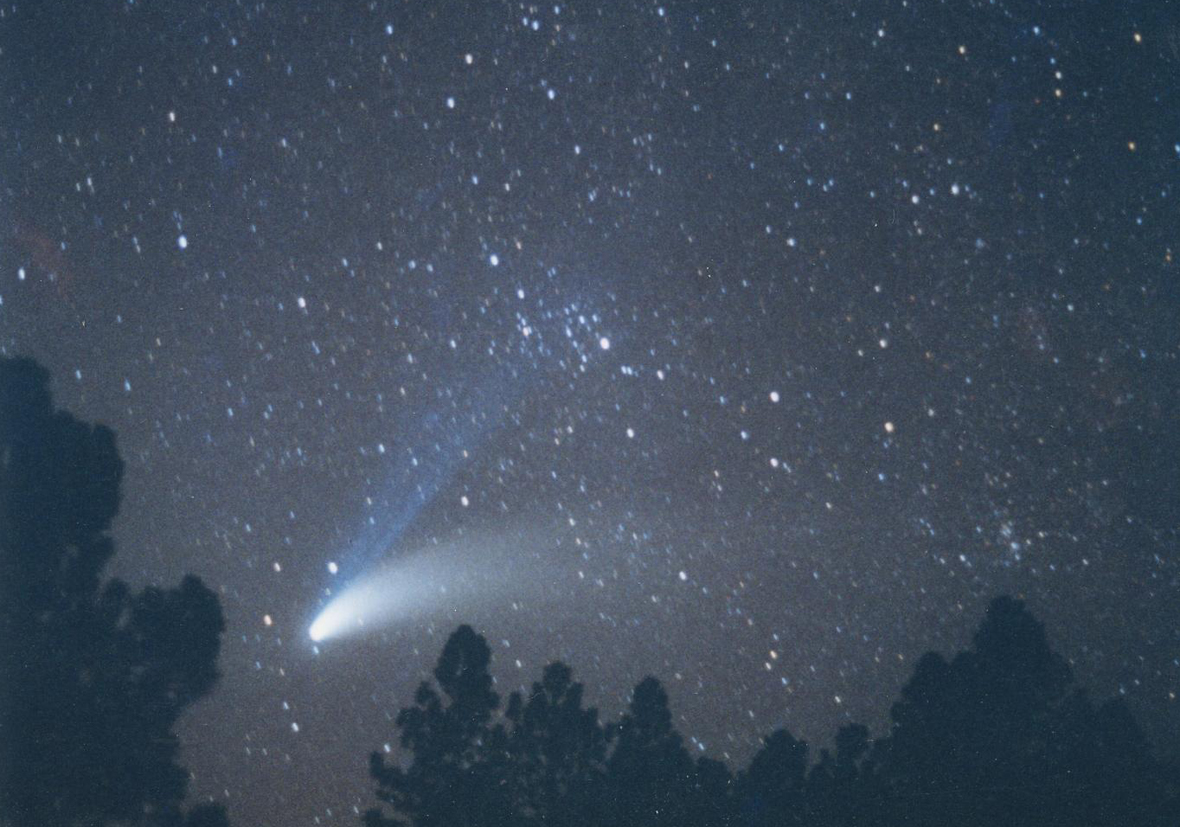
Of all the phenomena associated with comets, the one that more than any other gives them their beauty and their mystique is their tails. As recounted in a previous “Special Topics” presentation, the first recorded scientific observation of a comet concerned its tail: when observing the bright comet that appeared during the second half of 1531 – which we now know to be a return of Comet 1P/Halley – the German philosopher Petrus Apianus (Peter Apian) in Bavaria noted that the comet’s tail was always directed away from the sun.
Anyone who has observed several comets, or examined images of several comets, will have noticed that not all cometary tails are equal. Some are straight and narrow, others are broad and curved, some are short, some are long – and they can change their appearances over time. Many comets exhibit at least two tails, although the differences in intensity between these two tails can vary from comet to comet, and even from time to time with the same comet. While he perhaps wasn’t the first person to do so, in 1914 astronomer Edward Barnard at Yerkes Observatory in Wisconsin pointed out that, for Comet Delavan 1913f – this week’s “Comet of the Week” – the straight tail was more prominent photographically (especially in photographs taken with blue-sensitive emulsions) than visually, whereas the curved tail was the exact opposite. This reinforced earlier ideas he had expressed that different mechanisms were almost certainly responsible for the development of the two tails. He turned out to be correct, although it would be several decades before satisfactory explanations for these different mechanisms would be advanced.
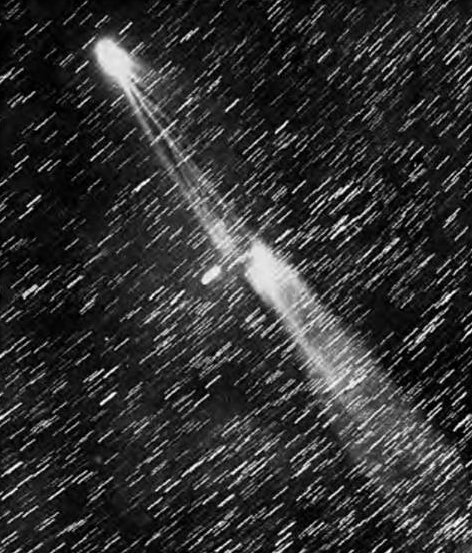
A comet that had appeared a few years earlier, Comet Morehouse 1908c, had a tail which was inconspicuous visually but which was quite prominent when photographed, and which exhibited dramatic changes on a night-to-night basis and sometimes even during the course of a single night. These changes were so dramatic and so rapid that Barnard suggested some electrical forces – similar to what are present in aurora displays – might be responsible. Based upon his own studies of Comet Morehouse, the British astronomer Arthur Eddington – who would later have a distinguished career in stellar astrophysics and cosmology – independently reached similar conclusions, at one point even suggesting that “a swarm of ions proceeding from the Sun and encountering the comet” was responsible for the activity the comet displayed.
For the most part, these suggestions lay dormant for the next few decades. Finally, in the late 1940s and early 1950s the German astronomer Ludwig Biermann proposed a “solar corpuscular radiation” as being responsible for the rapidly changing phenomena in a comet’s tail and the fact that it was always directed away from the sun. Later in the 1950s an American astrophysicist, Eugene Parker – for whom NASA’s Parker Solar Probe, launched in August 2018, was named – expanded these ideas and incorporated other solar phenomena and proposed the existence of a “solar wind,” a constant stream of ionized particles “blowing” off the sun. Parker’s ideas were quite controversial at the time, in fact, two of the referees of his submitted paper recommended its rejection, although the editor of the Astrophysical Journal published it anyway. The Soviet Union’s Luna 1 mission in early 1959 recorded measurements of what appeared to be this “solar wind,” and in 1962 NASA’s Mariner 2 mission to Venus – the first successful interplanetary probe – confirmed the solar wind’s existence while en route to that world.
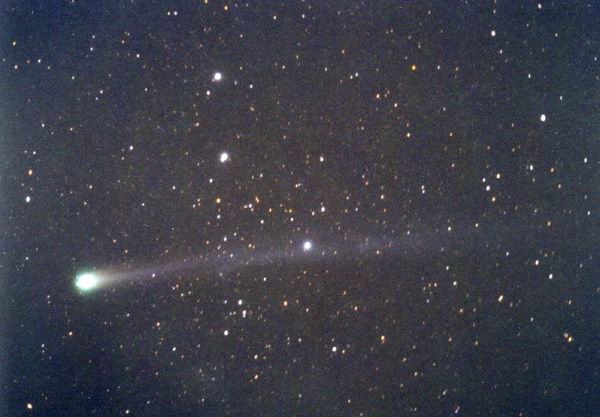
The solar wind is made up of electrons, protons, and various ions – all electrically charged. It generally “blows” at approximately 400 km/second, although the overall flow is complex and depends in part on the sunspot cycle. At the same time, solar flares and coronal mass ejections can affect the solar wind, sometimes dramatically. These various effects produce what we call “space weather,” and among other things are responsible – as Barnard suggested – for displays of the aurora (caused when the solar wind, interacting with Earth’s magnetic field, ionizes atoms in the gases of the upper atmosphere, which then emit photons of light when they recombine with the stripped electrons).
Ultraviolet radiation from the sun breaks apart the molecules of the sublimated ices contained within a comet’s nucleus, and then ionizes the atoms of these “daughter” atoms and molecules. The solar wind then interacts with these ions, thus “blowing” them back behind the comet, creating what is usually called the comet’s “ion tail” or sometimes its “plasma tail” (a plasma in this context being ionized gas). Carbon is a common “daughter” product (from carbon monoxide, carbon dioxide, and methane, among other “parent” molecules), and since ionized carbon molecules emit light primarily in the blue end of the spectrum, the ion tails are accordingly bluish in color (and thus prominent in blue-sensitive photographic emulsions and CCD chips). The structure of a comet’s ion tail can reflect changes and variations in strength of the solar wind, and thus is in effect a windsock for the solar wind.
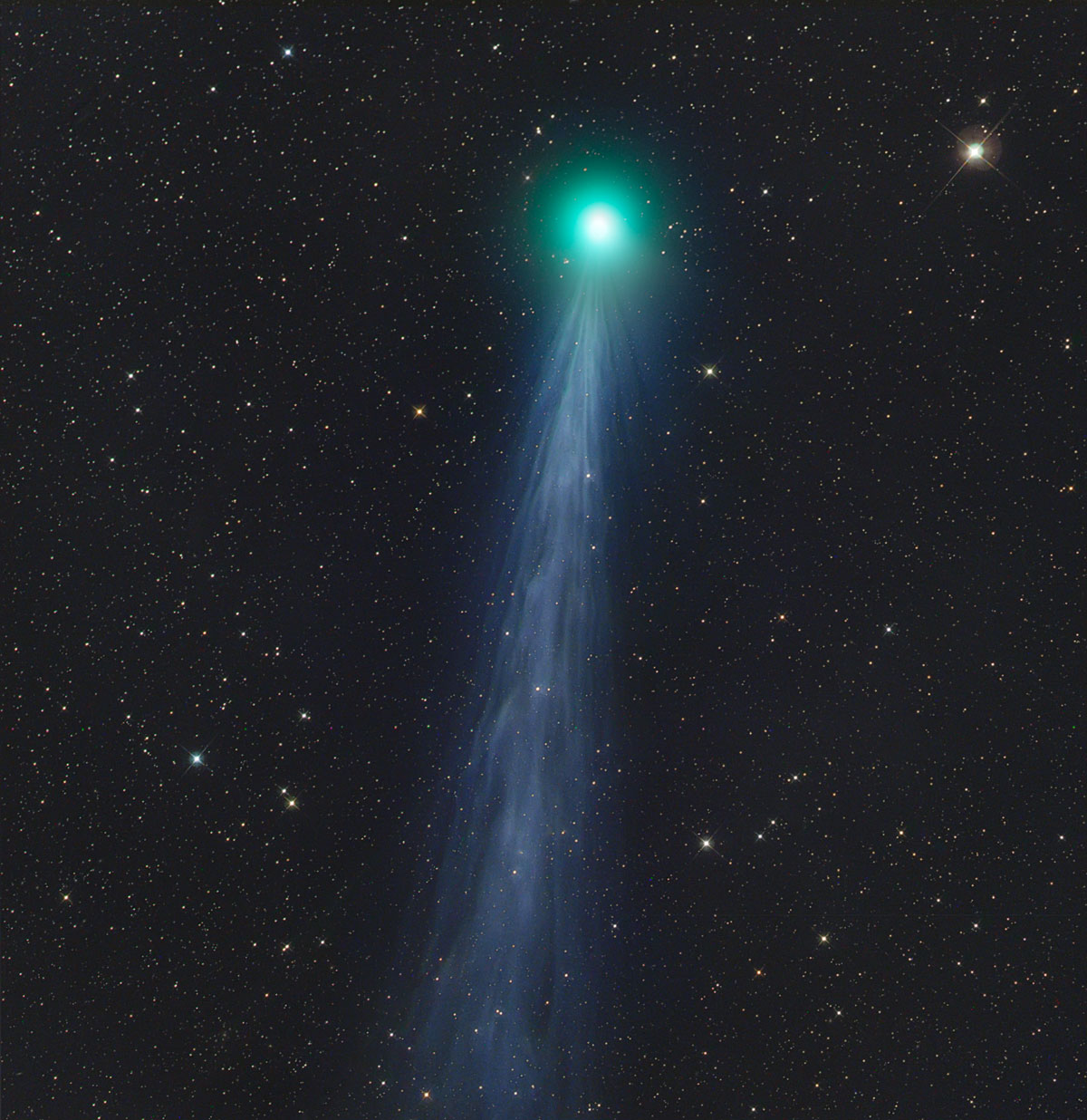
In the late 1950s the Swedish physicist Hannes Alfven pointed out that the solar wind – still a theoretical construct at that time – would, upon encountering the electrically charged ions around a comet’s coma, split into two oppositely charged halves which would then “drape” around the comet – a prediction verified in 1985 when the International Cometary Explorer (ICE) mission passed through the ion tail of Comet 21P/Giacobini-Zinner (last week’s “Comet of the Week”). At times the solar wind can be strong enough that it pinches the magnetic field lines in the ion tail together, producing what is called a “disconnection event.” Such events are quite common and have been observed in numerous comets. There have even been occasions, especially when a comet has encountered phenomena like coronal mass ejections, that it has all but had its ion tail ripped away completely.
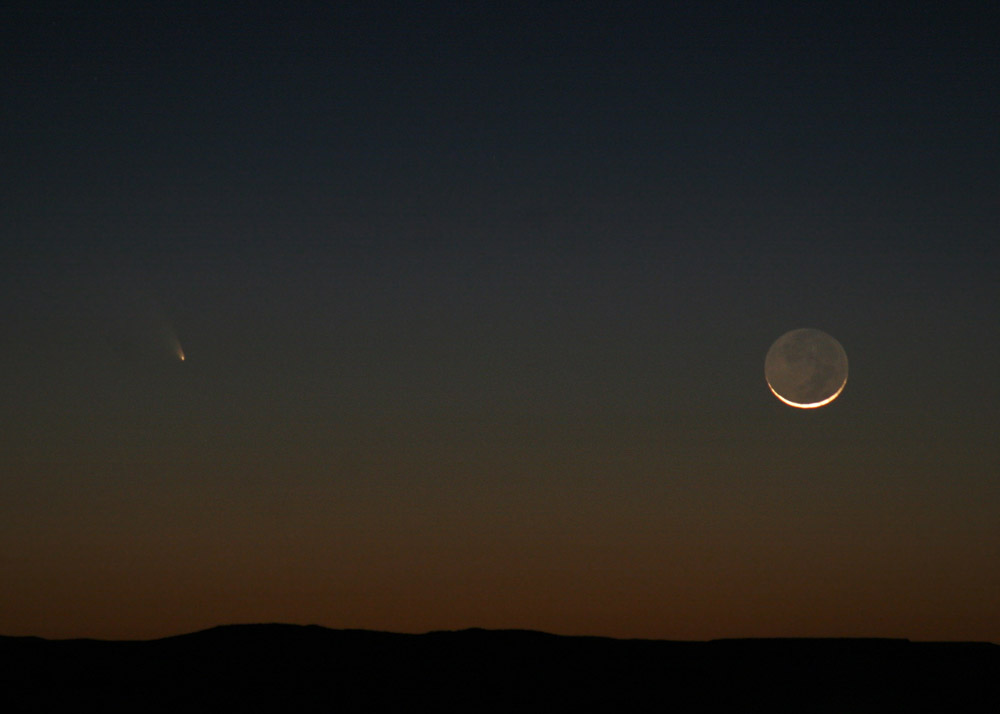
Embedded within the frozen ice of a comet’s nucleus are large amounts of dust grains, and as this ice sublimates upon encountering sufficient heat from sunlight these dust grains are ejected from the nucleus along with the sublimating gas. Since the nucleus is rotating this constant stream of dust spirals out away from the nucleus in the same manner that water jets spiral out away from a spinning water sprinkler, and this can create “hood”-like structures within the inner coma. Some comets, Hale-Bopp among them, have exhibited strong distinct “hoods” within their comae due to this phenomenon. As these dust streams continue spiraling away from the nucleus they spread out and merge with each other, creating a continuous expanse of dust.
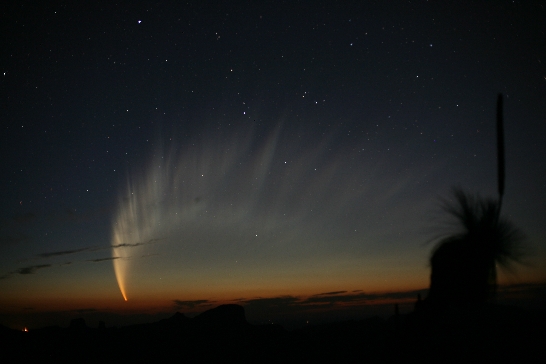
In the mid-19th Century, the Scottish physicist James Clerk Maxwell mathematically demonstrated that light exerts pressure, and in the late 19th and early 20th Centuries this was explored more thoroughly and experimentally by Russian physicists Pyotr Lebedev and Fyotr Bredikhin and Swedish scientist Svante Arrhenius. For objects as small as cometary dust grains, the sun’s radiation pressure is stronger than its gravitational attraction, and consequently, the dust grains are pushed back behind the comet. In effect, each dust grain goes into its own orbit around the sun, and as they lag farther and farther behind the comet itself they begin to form the comet’s dust tail that, due to the comet’s own orbital motion, usually exhibits distinct curvature. These dust grains “shine” by reflected sunlight, and thus they appear whitish, perhaps slightly yellowish, in color, and since our eyes are more sensitive to this than they are to the bluish coloration of ion tails, the dust tails are accordingly more prominent visually than are ion tails.
There is a wide variation among comets as to their relative populations of ice, i.e., gas, and dust. Those comets that are relatively low in dust content may exhibit strong and complex ion tails but never develop much of a dust tail. On the other hand, those comets with a high dust content can exhibit bright and long dust tails but may only exhibit a relatively weak ion tail. Since it takes a while for a substantial dust tail to develop even dust-rich comets may not exhibit much of a dust tail early on, and for such comets, the dust tails tend to be brighter and longer after perihelion than before.
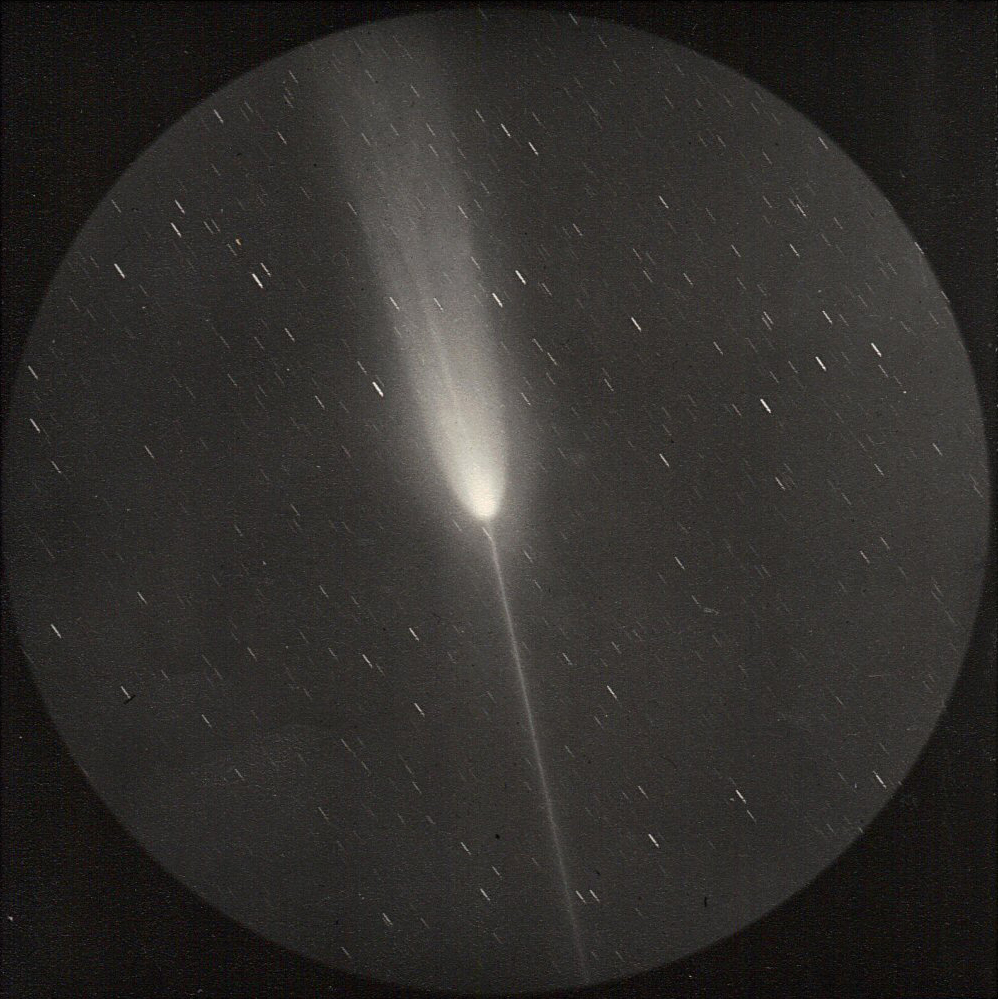
In addition to the regular continuous release of dust, some dust-rich comets, especially those that pass close to the sun, may experience regular episodes of ejections of large amounts of dust from specific active areas that rotate into and then out of sunlight. The individual dust grains in these “mass ejections” will vary in size, and the radiation pressure in sunlight will accelerate the smaller grains away from the nucleus faster than the larger grains. The result from a single event is the appearance of a “ray”-like structure within the dust tail, and with multiple events, the overall appearance is that of a series of slightly non-parallel “bands” in the tail. These features are usually referred to as “synchronic bands,” and some of the brighter comets that have appeared over time – including some that have been featured as “Comets of the Week” – have exhibited these, two recent examples being Comet McNaught C/2006 P1 shortly after it passed through perihelion in early 2007 and Comet NEOWISE C/2020 F3 which was a bright object in our skies two months ago.
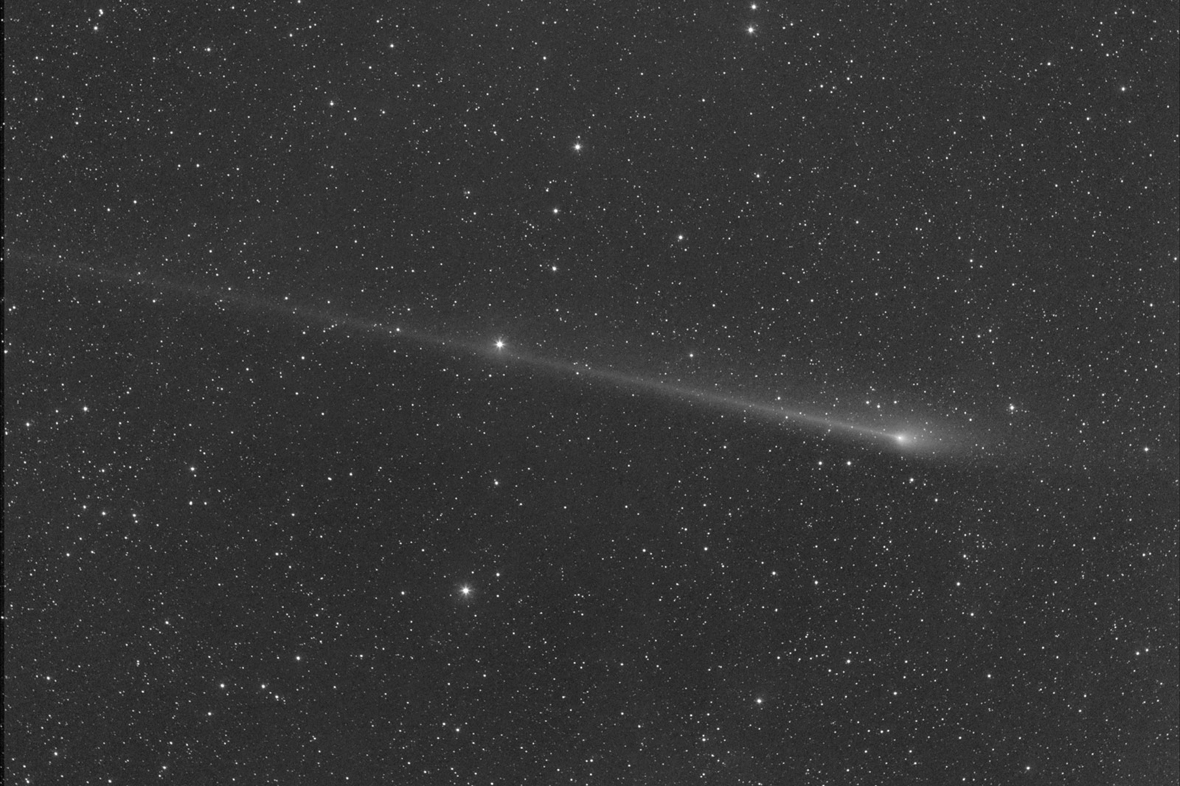
Sometimes the viewing geometry of a comet is such that when Earth crosses the comet’s orbital plane, the dust grains that have been lagging far behind the comet can appear to lie between the comet and the sun, creating what is called an “anti-tail.” Contrary to what is normally seen of a comet’s tail, this feature will appear to be directed towards the sun, but this is merely a projection effect. Several comets have exhibited distinct and prominent anti-tails, one of the more dramatic examples being Comet Arend-Roland 1956h – a previous “Comet of the Week” – after it had passed through perihelion in 1957.
Other tail phenomena have occasionally been seen with various comets as well. Shortly after Comet Hale-Bopp had passed through perihelion in April 1997 a team of astronomers at La Palma Observatory in the Canary Islands detected a narrow straight tail composed of fluorescing sodium atoms. Meanwhile, images of Comet Hyakutake C/1996 B2 taken by the LASCO C3 coronagraph aboard the SOlar and Heliospheric Observatory (SOHO) spacecraft as the comet was passing through perihelion revealed, in addition to the regular ion and dust tails, a third straight tail that subsequent analysis indicated was made up of massive particles that had been ejected from the nucleus during the preceding few days.
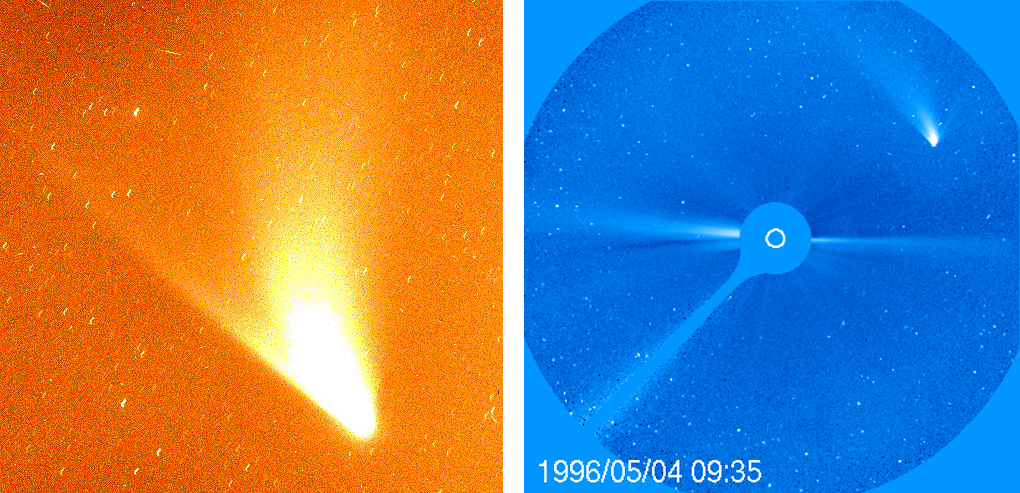
Besides SOHO, other spacecraft have sometimes revealed cometary tail features that might have otherwise escaped detection. During its operational lifetime in 1983, the InfraRed Astronomical Satellite (IRAS) spacecraft detected long dust “trails” accompanying several comets within the inner solar system, most strikingly with Comet 10P/Tempel 2 which passed through perihelion during the middle of that year. (An IRAS image of Comet 10P’s dust trail is featured in a previous “Special Topics” presentation.) Magnetic field data taken by ESA’s Ulysses mission in May 1996 – at which time it was located at a heliocentric distance of 3.7 AU – indicated that Comet Hyakutake’s ion tail was at least 3.8 AU long and moreover exhibited distinct curvature, contrary to most commonly-held ideas about ion tails.
While many of the processes that affect the formation and development of comets’ tails are understood relatively well, there are still gaps within that knowledge that only additional observations will be able to fill in. There are plenty of physical processes going on within a comet that produce the various features we observe, and in a sense we can consider a comet as a cosmic physics laboratory – one that is accessible to all of us, and, with each new comet that comes by, one that provides us an inexhaustible supply of subjects to examine.
More from Week 39:
This Week in History Comet of the Week Free PDF Download Glossary
Ice and Stone 2020 Home Page


